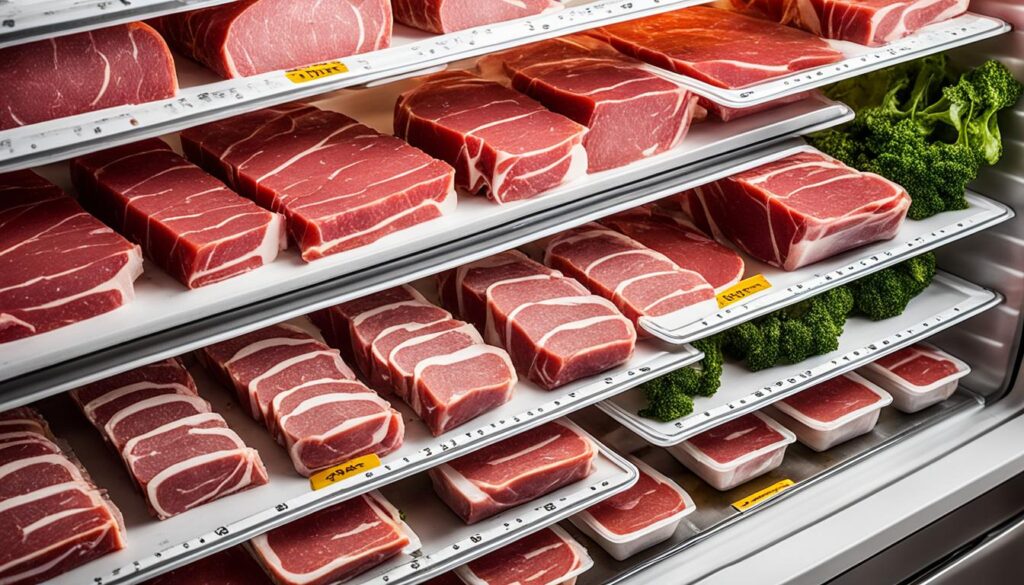Lunch meat, also known as deli meat or luncheon meat, is a key item in many American kitchens. It’s perfect for packing a sandwich for work or making a quick meal at home. Knowing how long these meats stay fresh is important. This guide will cover how long different lunch meats last, what affects their shelf life, and how to keep them fresh and safe.
Dealing with lunch meat can be a bit confusing, as its shelf life changes with the type of meat, how it’s made, and how you store it. By learning about lunch meat freshness, you can decide when to eat your favorite deli meats. You’ll also know how to store them to keep them fresh longer.
Understanding Lunch Meat Shelf Life
The shelf life of lunch meats depends on many factors. These include how they are processed, packaged, and stored. Each of these can affect how long they stay fresh and safe to eat.
Factors Affecting Freshness Duration
Several elements impact the freshness duration of lunch meats:
- Processing Techniques: Meats that are more processed, like cured or smoked, last longer than those that are not.
- Packaging: Using airtight or vacuum-sealed packaging helps keep meats fresh by keeping out oxygen and other factors.
- Storage Conditions: Keeping meats in the fridge at the right temperature is key. Freezing can also make them last longer.
Types of Lunch Meats and Their Shelf Lives
Not all lunch meats last the same amount of time:
| Meat Type | Refrigerated Shelf Life | Frozen Shelf Life |
|---|---|---|
| Sliced Ham | 3-5 days | 1-2 months |
| Roasted Turkey Breast | 3-5 days | 2-3 months |
| Salami | 2-3 weeks | 1-2 months |
| Pastrami | 3-5 days | 1-2 months |
Remember, these are just general guidelines. The actual lunch meat shelf life can change based on the brand, how it’s made, and how it’s stored.
Proper Storage Techniques for Lunch Meats
Keeping your lunch meats fresh and safe starts with the right storage. By using best practices for refrigerated meat storage and freezing, you can make your favorite deli meats last longer. This ensures they stay tasty and healthy.
Refrigeration Guidelines
For storing lunch meat in the fridge, keep the temperature right. Try to keep your fridge between 35°F and 40°F to stop harmful bacteria from growing. Put deli meats back in their original packaging or use airtight containers to keep them fresh.
Freezing Options for Extended Storage
Freezing is great for keeping deli meats for a long time. Wrap sliced or whole lunch meat in plastic wrap or freezer paper. Then, put them in a resealable freezer bag. Frozen lunch meat can last up to 2-3 months, which is perfect for meal prep and controlling portions.

“Proper storage is the key to maintaining the freshness and safety of your lunch meats.”
By following these easy refrigeration and freezing tips, you can keep your favorite deli meats fresh for a longer time. This ensures they stay tasty and healthy for all your lunches.
How Long Is Lunch Meat Good For?
The shelf life of lunch meats depends on the type and how you store them. Pre-packaged deli meats usually last longer than fresh ones from the deli counter. Homemade or artisanal lunch meats tend to have a shorter shelf life.
Unopened lunch meat packages can last up to 2 weeks after the “use by” date in the fridge. After opening, eat it within 3 to 5 days. In the freezer, both opened and unopened packages can last 1 to 2 months for the best taste.
Freshly sliced deli meats don’t last as long, usually 3 to 5 days in the fridge. They’re more likely to grow bacteria because they’re exposed to air and handled more. Keeping them in an airtight container or resealable bag helps extend their lunch meat shelf life.
Homemade or artisanal lunch meats, made with special curing, have a shorter shelf life. They can last from 3 to 7 days in the fridge. These meats don’t have the preservatives found in store-bought ones, so they spoil faster.
“Proper storage and handling are crucial to ensuring the safety and longevity of lunch meats.”
It’s important to watch for any signs of spoilage, like bad smells, color changes, or sliminess. If you’re unsure, throw it away. Knowing how long lunch meat stays good helps you enjoy your favorite deli meats safely and fresh.
Signs of Spoilage in Deli Meats
Knowing how to spot spoilage is key to keeping lunch meats safe and fresh. By watching for changes in look, smell, and feel, you can tell when it’s time to throw away an expired deli product.
A slimy or sticky film on the surface is a clear sign of spoilage in lunch meat. It means bacteria are growing and the meat is breaking down. Also, if the meat looks different, like faded or discolored, it’s likely past its best.
Our sense of smell can tell us when lunch meat has gone bad. A strong, bad smell coming from the package means the meat is spoiled and unsafe to eat. A sour or ammonia-like smell also means the meat is starting to decompose.
Texture is another way to check if lunch meat is still fresh. If it feels dry, crumbly, or gooey, it’s not good. This means the meat has gone bad and is not safe to eat.
“When in doubt, throw it out. It’s better to be safe than sorry when it comes to consuming expired lunch meat.”
By staying alert and paying attention, you can make sure you only eat fresh, quality lunch meats. This helps avoid foodborne illnesses and keeps the meat freshness duration longer.
Health Risks of Consuming Expired Lunch Meat
Eating expired or spoiled lunch meats can be dangerous. It can lead to foodborne illnesses. These meats may have harmful pathogens like Salmonella, Listeria monocytogenes, and Clostridium botulinum. These pathogens can cause serious symptoms.
Foodborne Illnesses and Symptoms
When you eat contaminated meat, you might get foodborne illnesses. These illnesses have different symptoms. Here are some common ones linked to expired lunch meats:
- Salmonellosis: Symptoms include diarrhea, fever, and stomach cramps. They usually start 12 to 72 hours after eating.
- Listeriosis: It can cause fever, muscle pain, and stomach problems. Symptoms may show 1 to 4 weeks after eating.
- Botulism: This can cause severe symptoms like paralysis, breathing problems, and even death. Symptoms can start as soon as 18 to 36 hours after eating.
These illnesses can be very dangerous for some people. This includes the elderly, pregnant women, young kids, and those with weak immune systems. It’s important to follow meat safety guidelines and store food right. This helps avoid the health risks of expired meats and stops foodborne illnesses.
| Foodborne Illness | Causative Pathogen | Symptoms | Onset Time |
|---|---|---|---|
| Salmonellosis | Salmonella | Diarrhea, fever, abdominal cramps | 12-72 hours |
| Listeriosis | Listeria monocytogenes | Fever, muscle aches, gastrointestinal issues | 1-4 weeks |
| Botulism | Clostridium botulinum | Paralysis, respiratory failure, potentially fatal | 18-36 hours |
Maximizing Lunch Meat Freshness
Keeping your favorite lunch meats fresh and tasty is key for a great meal. By using smart habits, you can make packaged deli meats last longer. This section offers tips on portion control, meal planning, and more to reduce waste and keep your lunch meats in top shape.
Portion Control and Meal Planning
Controlling how much you eat is crucial for storing lunch meat and keeping it fresh. Divide your meat into portions before storing to prevent over-buying and spoilage. Use containers or bags that seal well to store these portions, making them easy to take with you.
Planning your meals helps with portion control and keeps things interesting. Spend a few minutes each week to plan your lunches. Buy only the lunch meat you’ll use, which cuts down on waste and lets you try different meats. This makes your lunches more fun and healthy.
- Invest in airtight containers or resealable bags to store individual portions of lunch meat.
- Plan your weekly lunches in advance to avoid over-purchasing and reduce the risk of spoilage.
- Rotate through a variety of lunch meats to keep your midday meals exciting and balanced.
“Portion control and meal planning are the keys to maximizing the freshness and flavor of your lunch meats.”

These easy steps help you enjoy your favorite deli meats without wasting food or losing freshness. With a bit of planning and control over portions, you can enjoy your lunch meats for a longer time.
Lunch Meat Safety Guidelines
Keeping lunch meats safe is key for a healthy diet. By following important meat safety, storing lunch meat, and preserving deli meats tips, you can enjoy your favorite deli items safely. This way, you get to enjoy the taste and convenience without worrying about getting sick.
Proper Handling and Storage
Here are some tips to keep your lunch meats fresh and safe:
- Keep unopened packages in the fridge at 40°F or below. Use them before the expiration date.
- After opening, wrap the meat well and refrigerate it. Use it in 3-5 days.
- Don’t leave lunch meats at room temperature for over 2 hours (1 hour in hot weather).
Safe Reheating Practices
When reheating your lunch meat, make sure it gets to 165°F. This kills harmful bacteria.
“Proper handling and storage are key to ensuring the safety and longevity of your deli meats.”
Recognizing Spoilage
Watch out for signs of spoilage like a slimy feel, off-color, or bad smell. If it looks or smells off, throw it away to stay safe.
| Meat Type | Refrigerator (40°F or below) | Freezer (0°F or below) |
|---|---|---|
| Unopened Package | 2-3 weeks | 2-3 months |
| Opened Package | 3-5 days | 1-2 months |
By sticking to these meat safety guidelines, you can enjoy your favorite deli meats safely. This way, you keep your health and well-being in check.
Reviving Stale Lunch Meat
Don’t worry if your lunch meat is getting old. There are many ways to make it fresh again. You can cook it or use it in tasty dishes. This part will show you how to make the most of your leftover lunch meat.
Creative Recipes and Repurposing Ideas
One great way to make stale deli meats tasty is by using them in recipes. Chop the meat and cook it with veggies, herbs, and sauce. This makes a great filling for omelets, sandwiches, or pasta.
You can also add the meat to soups, casseroles, or fried rice. This gives your dishes more protein and texture.
If you like to make snacks, use lunch meat to make your own. Cut the meat into strips, season it, and bake or air-fry it. You’ll get delicious meat chips or jerky. These are great snacks that help you use up your deli meats.
For a crunchy snack, mix stale lunch meat with breadcrumbs or crushed crackers. Use it as a coating for chicken, fish, or veggie patties. You’ll get a tasty, crispy dish from your leftover deli meats.
The secret to making stale lunch meat tasty is to be creative. Try different cooking methods and recipes. By using these meats in new ways, you can enjoy more delicious meals and save food.
Eco-Friendly Disposal of Expired Meats
It’s key to dispose of expired or spoiled lunch meats the right way for food safety and the planet. When luncheon meats are no longer good, we should handle them in a green way. This means recycling or composting the meat to cut down on waste and support the earth.
If you can’t compost or recycle the meat, throw it away through your local waste system. Many places have rules for throwing away food, and following them keeps everyone safe. Some places even have special pickups for organic stuff, making it easy to get rid of old lunch meat the right way.
By following safety tips and choosing green ways to get rid of expired meats, we all help the planet. This keeps our community and the earth healthy.










